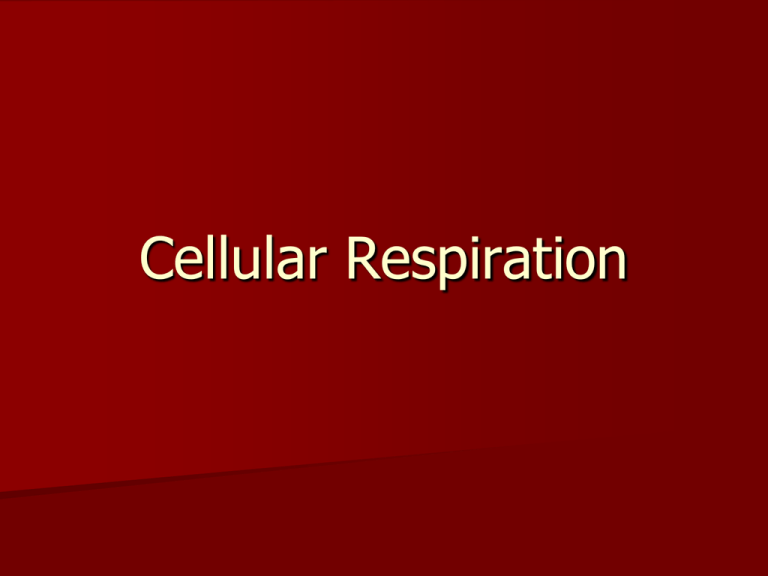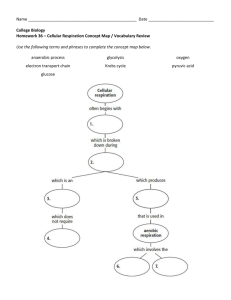Cellular Respiration
advertisement

Cellular Respiration Cellular Respiration…What is it? -process by which cells make ATP by breaking down organic compunds. Why is it important? -cells need usable forms of energy to function and maintain homeostasis. It all starts with: Glycolysis Cellular Respiration begins with a biochemical pathway called glycolysis. (no oxygen is present.) -one glucose molecule is broken down (oxidized) to produce two molecules of pyruvic acid. -The net yield of glycolysis is two ATP molecules. -After glycolysis, the oxidation process continues in the presence or absence of oxygen. Fermentation (Anaerobic) no oxygen Fermentation occurs after glycolysis when oxygen is absent within the cells. -No ATP is generated. However, NAD+ is regenerated which is needed in glycolysis. -Two common fermentation pathways: 1. Lactic Acid Fermentation 2. Alcoholic Fermentation 1. Lactic Acid Fermentation Enzymes convert pyruvic acid into lactic acid. -Lactic Acid Fermentation is important in the manufacturing of various foods. (yogurt, cheese) -Athletes also experience Lactic Acid buildup…cramping and fatigue. 2. Alcoholic Fermentation Enzymes convert pyruvic acid into ethyl alcohol. -Process is done by some plants and yeast. -This process is important in the bread, beer and wine industry. Aerobic Respiration oxygen present Occurs in the presence of oxygen. Net ATP production is much greater! Two major steps: 1. Krebs Cycle (citric acid is formed) 2. Electron Transport Chain In prokaryotes, occurs in the cytoplasm. In eukaryotes, occurs in the mitochondria. Krebs Cycle (Citric Acid Cycle) When pyruvic acid enters the mitochondria, acetyl CoA is formed. The Krebs Cycle breaks down the acetyl CoA producing CO2 , hydrogen atoms, and ATP. (NADH, FADH2) Each glucose molecule yields only two molecules of ATP through the Krebs Cycle. Electron Transport Chain So far, not much ATP has been produced. The Krebs Cycle produces NADH and FADH2 which drives the Electron Transport Chain. Occurs in the membrane of the mitochondria. After the ATP is produced, it diffuses into the cytoplasm. ATP is produced by the release of hydrogen atoms from NADH and FADH2. (chemiosmosis) Oxygen is necessary and ends up forming water. Final Thoughts… Net production of ATP through aerobic respiration…36 ATP. The oxidation of glucose can be summarized in the following equation: C6H12O6 + 6O2 → 6CO2 + 6H2O + energy (ATP) Not only does Cellular Respiration provide ATP, it also makes carbon ‘skeletons’ that can be made into larger molecules needed by the cells.




